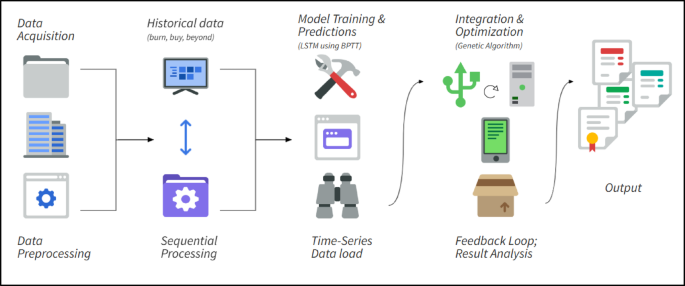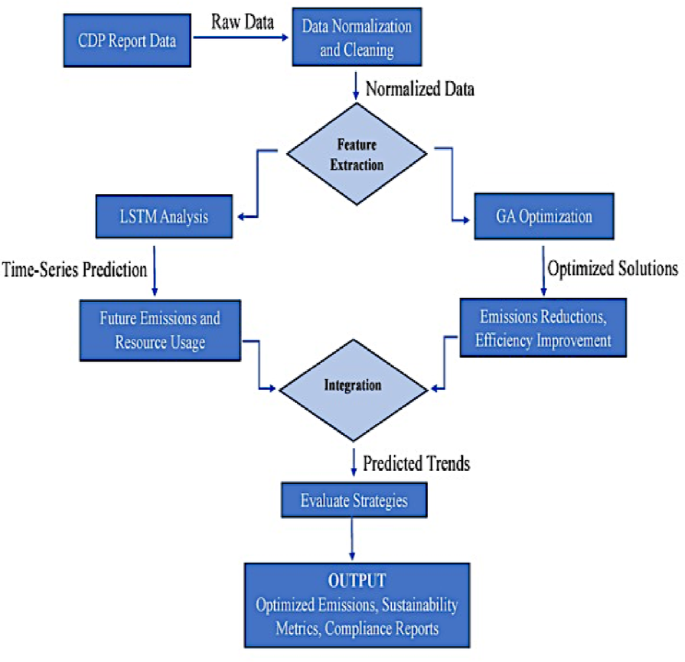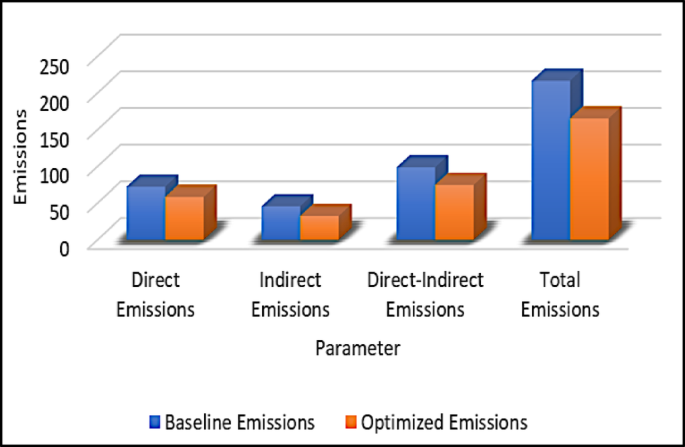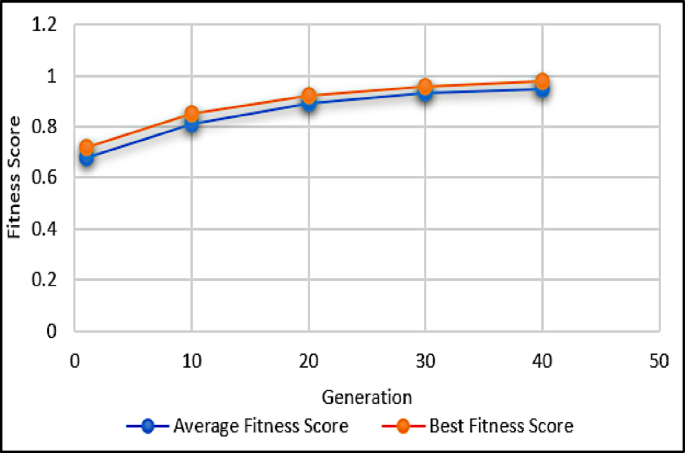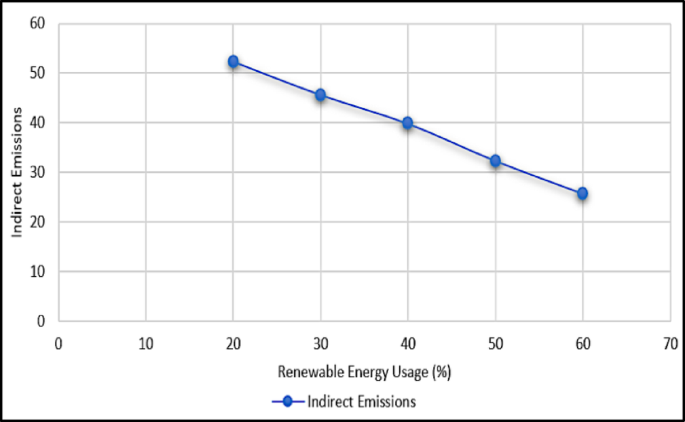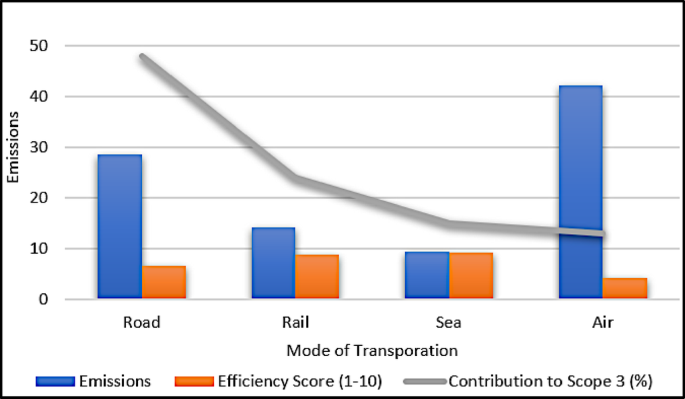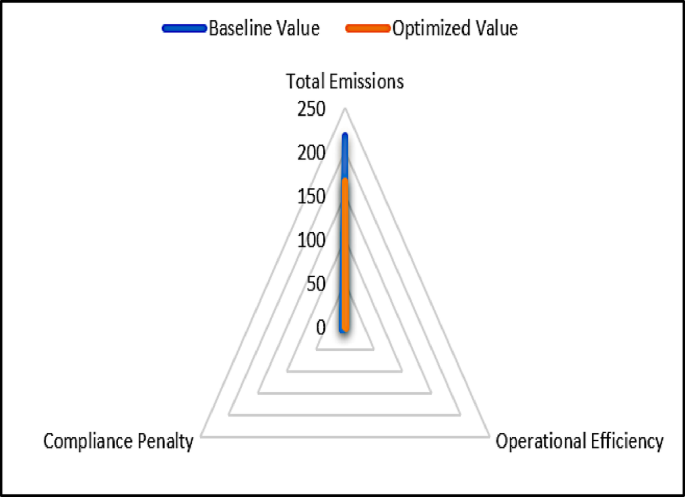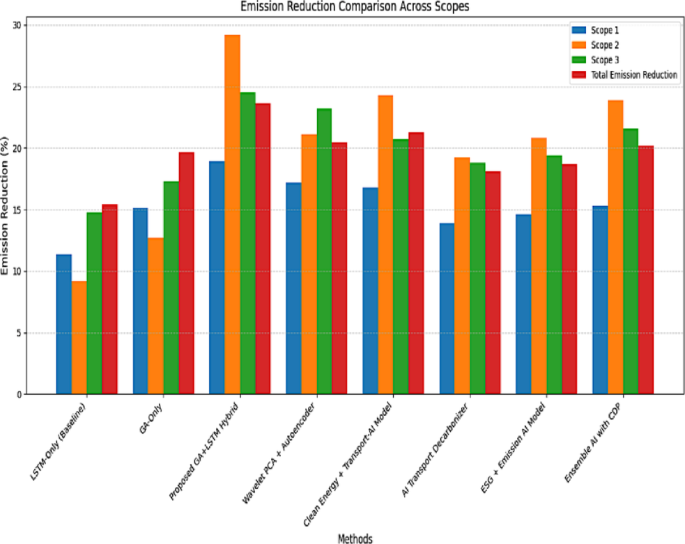AI驱动的自动化以增强CDP报告分析中的可持续性工作
作者:Shankar, Krithik
介绍
气候变化的日益影响强调了整个行业可持续性的迫切需求。最紧迫的问题之一是碳排放,能源效率低下和资源过多。政府,公司和消费者越来越优先考虑可持续性,旨在减少环境影响,同时确保运营效率和财务可行性。在这方面,诸如人工智能(AI)和优化算法等尖端数据驱动的策略已成为解决可持续性问题的有效工具。CDP为组织报告其环境绩效提供了关键的平台,包括排放数据,能源使用和其他可持续性指标。尽管具有标准化的数据集,但许多组织依靠无法有效捕获动态环境挑战的静态分析方法,使许多组织不利于CDP报告。此外,实时IoT传感器数据虽然有用,但通常很昂贵,部署复杂,并引起了对数据隐私和可扩展性的担忧。因此,利用结构化CDP数据提供了一种既可以访问又具有成本效益的替代方案。
为了应对这些挑战,本研究提出了一个集成LSTM网络和GA以优化可持续性成果的混合框架。LSTM网络利用历史数据趋势来预测排放,而GA通过降低排放,成本效率和法规合规性来优化预测。这种集成消除了对昂贵的实时数据收集的依赖,并为各种规模的企业提供了可扩展的可持续性解决方案。
问题陈述
可持续性优化的挑战在于平衡企业的经济可行性与需要环境管理。传统优化技术通常无法捕获环境系统中的动态相互依赖性,因此需要采用AI驱动的解决方案。通过利用结构化的CDP数据,本研究介绍了一种基于预测和优化的方法,该方法在确保业务竞争力的同时最大程度地降低了环境影响。该框架使企业能够使用历史数据趋势预测排放,然后应用GA来优化多目标目标,包括减少排放,成本效率和遵守法规。
提出的AI驱动框架
在解决可持续性问题方面,人工智能是改变游戏规则的人,因为它允许企业检查大量数据,效率低下和简化流程。提出的框架集成了两种关键的AI技术:用于排放预测的LSTM网络和用于可持续性优化的GA。用于排放预测的LSTM网络
LSTM网络是一种经常性神经网络(RNN),它在处理顺序数据并捕获长期依赖性方面擅长,使其非常适合预测排放和资源消耗的趋势。
分析过去排放趋势的能力使LSTM可以预测未来的排放,从而为企业提供了计划主动可持续性策略所需的远见。鉴于CDP数据的结构化性质,这些网络能够有效地处理环境数据中固有的非线性趋势和长期关系。结果,基于LSTM的模型提供了准确的预测,使组织能够预测和减轻排放量的增长,然后再超过目标阈值。
多目标优化的遗传算法
GA是一种受自然选择原理启发的优化技术,它进化了候选解决方案以识别最佳结果。在可持续性的背景下,天然气可以帮助组织在相互矛盾的目标之间导致复杂的权衡,例如减少碳排放,最大程度地减少运营成本并遵守监管标准。通过在连续几代人的发展方面发展解决方案,GA确保最终解决方案可以最佳地平衡这些竞争优先级,从而产生最大程度地减少排放量的策略,同时提高业务绩效。
GA在可持续性优化方面具有至关重要的优势,因为它可以同时考虑多个因素并动态调整解决方案,从而考虑了可持续性挑战中存在的复杂的非线性关系。
主要结果和贡献
这项研究通过将基于LSTM的预测和GA优化整合到混合框架中,提供了一种新颖的可持续性优化方法。这项研究的主要结果包括:
准确的排放预测:通过使用CDP报告中的历史排放数据,LSTM网络可产生对未来排放趋势的精确预测。这使企业可以预测其碳足迹的潜在增加,并积极实施纠正措施。
多目标优化:GA使企业能够优化减少排放,成本效率和法规合规性之间的权衡。这种多目标优化可确保实现可持续性目标而不会损害经济绩效,从而满足了对具有成本效益的环境战略的需求。
具有成本效益的可持续性监控:与依靠昂贵的实时IoT传感器的传统方法不同,拟议的框架利用结构化的CDP数据,该数据可访问,标准化且已经可用于许多组织。这降低了实施可持续性监控系统的成本和复杂性,使它们更容易被各种规模的企业访问。
可扩展和自适应框架:混合框架设计为在不同行业和业务规模之间可扩展。它适应不断变化的环境条件和不断发展的法规,确保长期可持续性改善,同时保持业务竞争力。
本文的结构如下。第二节对相关工作进行了全面的审查,研究了现有的AI驱动和优化的可持续性方法,并概述了其关键局限性,尤其是与数据依赖性,可伸缩能力和预测能力有关的关键局限性。第四部分概述了实验设置,并列出了经验评估的结果,证明了该框架在减少排放效率的同时保持运营效率的有效性。最后,第六节总结了这项研究,并提供了旨在增强AI驱动可持续性优化系统的可扩展性,准确性和适应性的未来研究方向的见解。
相关作品
在一个快速的技术进步和不断提高的全球互连性的时代,对可持续实践的需求变得比以往任何时候都更加紧迫。气候变化,资源耗竭和环境退化是全球行业面临的关键挑战。解决这些问题需要紧急关注减少碳排放,优化资源利用并促进对环境负责的运营。这些努力的核心是AI等先进技术的整合,以分析环境数据并开发与可持续性目标保持一致的解决方案。化石燃料的使用大大增加了温室气体排放,这加剧了全球变暖,碳排放和环境恶化。
组织越来越认识到减少碳足迹的好处,包括节省成本,法规合规性以及对与气候相关风险的弹性提高。随着行业优先考虑可持续性运营,诸如技术接受模型和创新的扩散之类的框架对于理解采用这些实践的障碍至关重要。这些框架通过解决环境意识和政策限制来帮助指导各个部门的企业的决策1。太阳能整合在减少碳足迹和解决化石燃料依赖方面起着至关重要的作用,尤其是在发展中国家。它表明整合太阳能可以显着减少碳足迹,同时解决化石燃料依赖的挑战,从而促进能源部门的可持续发展2。在分布式和联合学习中,能源和碳足迹评估的相关性呈指数增长,尤其是在工业4.0和5G技术领域。这巩固了可持续人工智能解决方案的重要性,研究了集中式学习方法之间的平衡3。
自然语言处理(NLP)技术可用于增强自动化系统的解释性,尤其是在计算银行交易中的碳足迹时。此外,对模型不足方法的研究在有效的绩效和用户信心方面产生了良好的结果,解决了通常在工业环境中与机器学习模型相关的透明度的缺乏4。在高等教育中,用于预测分析的AI工具有助于访问和减少运营活动(例如运输和能源使用)的碳足迹。这些工具支持向更可持续的教育机构的过渡,使他们与全球可持续性目标保持一致5。
由于许多硬件软件交互的复杂性,设计过程变得更加困难,这导致效率低下和更高的能量使用。此外,当前操作系统中资源分配中缺乏可持续性意识,要求创建优化框架和算法,这些框架和算法最大化资源效率,同时降低各种工作量的运营排放6。AI和大数据分析可用于优化低碳能量经济体,并在提高能源效率和降低碳排放方面证明了重要的发展。大数据技术(例如云计算和物联网)结合了各种AI方法,例如神经网络和粒子群优化,可用于实现这一目标7。
需要优化资源放置以减轻能源消耗和二氧化碳排放。此外,混合企业线性编程(MILP)模型和可再生能源资源的集成可以提高数据中心的能源效率,对于不断增长的云计算需求至关重要8。蒙特卡洛模拟在评估土地使用和资源管理的环境影响方面具有重要意义。这为可持续的农村经济贡献了更多。通过整合生态,社会学和经济方面,行业可以更好地评估各个部门的可持续性工作10。大数据和AI等新兴技术在促进联合国可持续发展目标(SDG)方面发挥了重要作用。ISO,IEEE和ITU等组织的国际标准促进了可持续的工业化,数字包容和经济发展,需要进一步的经验评估11。NLP技术分析了来自非结构化数据(例如财务新闻)的情感情绪,改善了碳价格预测模型。高级算法(如MS-IHHO-LSTM)通过将情感与市场数据相结合,增强了预测,强调了公众看法在碳定价中的作用12。
毫无疑问,在制造业中评估碳排放量并强调低碳制造工艺的重要性,因为它们的高能源消耗和温室气体排放至关重要。通过AI驱动的解决方案,还使能源密集型行业的可持续性努力(例如水泥生产)成为可能。通过实时调整加工参数,大数据分析有助于减少制造中的碳排放13。综合策略在促进可持续经济增长方面起着重要作用。绿色能源的产生和需求方控制措施提供了有关如何对能源和经济政策如何保持一致以减少气候变化的基本见解,同时促进可持续发展14。
通过了解电动汽车(EV)充电模式,诸如非侵入性负载监测(NILM)之类的技术在优化能源消耗方面有效,这对于管理碳排放至关重要。通过整合社会,心理和经济因素,能源预测模型可以在促进可持续能源管理方面变得更加有效15。AI超出了能源优化,成为碳足迹评估和会计。机器学习模型计算实时排放,帮助公司减少碳足迹。这些模型在智能城市中特别有用,在智能城市中,有关排放和能源使用的实时数据可增强可持续性,突出了数据驱动的碳管理的重要性16。
采用可持续性实践是由环境,经济和社会要求驱动的。收益包括节省成本,法规合规性,声誉增强和气候弹性。消费者对透明度的需求推动了行业优先考虑可持续性。在整个技术生命周期内整合可持续性,证明可以减少碳排放,同时提高效率。这可以显着降低碳排放,同时提高运营效率17。尖端的通信技术,例如物联网和机器学习,对于增强智能建筑的可持续性和能源效率至关重要。但是,在综合框架中存在一些整合几种技术的缺点,这表明需要更多的研究来解决数据安全性和互操作性的问题18。
可持续性得到了增强透明度的技术,例如区块链和数字平台,这些技术可帮助组织跟踪环境数据,验证合规性并为利益相关者提供可靠的信息。区块链在碳会计和排放报告中起关键作用19。机器学习算法(例如支持向量回归(SVR)和神经网络(NN))的集成在预测和优化碳排放方面有用。这些模型有助于开发可持续的混凝土解决方案,与联合国的可持续发展目标保持一致。在混凝土制造中纳入节能生产技术对于减少建筑部门的排放至关重要20。
研究21提出了一个用于织物缺陷检测的盲级超分辨率框架,通过使用Real-Esrgan和Poisson噪声降解来解决图像质量和数据集限制。作者引入了一种新型的局部模糊判别损失函数,从而增强了图像清晰度以进行缺陷检测。与传统的增强方法相比,DAGM2007数据集的实验结果显示出准确性,召回和平均精度(MAP)的显着提高。在22,作者通过将DAHL模型重新定义为神经网络结构(DAHLNN),并与层复发网络(LRN)相结合,来解决压电执行器中率依赖速率的滞后。这种可解释的混合模型通过将建模误差降低97.3%,并波动增加了70%,从而提高了运动控制精度,表现优于具有最小计算开销的标准LRN模型。研究中的研究23引入了一个视觉问题答案(VQA)系统,用于碳中立性,结合了计算机视觉和自然语言处理,以解释环境图像并提供可行的见解。VQA框架有助于确定碳排放热点,评估绿色计划,并支持基于证据的决策,促进可持续性和缓解气候变化。
在24,提出了针对汽车互联网(IOV)的深度学习入侵检测框架,并结合了高级加密技术,例如AES-256和同构加密(HE),以确保隐私。该系统使用小波变换,视觉变压器(VIT)和图形注意网络(GAT)进行特征提取,并具有混合DAGSNET架构进行有效的模型训练。对CAN和CIC-IDS2017数据集的评估表现出了出色的性能,在保持快速加密速度的同时达到了98%的精度。研究25提出了一种用于磁编码器误差的新型补偿方法,将变异模式分解(VMD)与使用粒子群优化(PSO)优化的深信念网络(DBN)集成在一起。该模型显着提高了机器人系统中角度检测的准确性,将角度误差从0.22°降低到0.0025°,并且表现优于传统的机器学习模型。在26,使用机器学习技术来预测椭圆双钢柱(EDSC)的轴向负载能力,而Adaboost模型达到了最高精度(R2= 0.996)和强大的概括能力。该研究为结构工程师提供了用户友好的图形接口,以提高构建的安全性和效率。最后,27评论智能审计的新兴领域,强调其在公共部门审计中的财务环境之外的应用。该研究探讨了使用机器学习和异常检测自动化审核的挑战,并呼吁跨学科协作创建更透明,可扩展的审核系统。
研究28使用联合学习和基于注意力的特征融合引入了一个用于早期心脏病检测的隐私性框架,并整合了多模式数据,例如心脏图像,ECG信号,患者记录和营养数据,可实现高精度(97.76%,98.43%,99.12%)。相似地,29使用海鸥优化算法(SGA)开发了一种用于分类的基因选择和随机森林(RF)的乳腺癌分类模型,仅使用22个基因达到99.01%的精度,表现优于传统模型。在神经发育领域,30提出了一个基于脑电图的ADHD检测系统,使用NeuroDCT-ICA预处理和ADHD-InternitionNet,达到98.52%的精度,而31提出了一个复合框架,用于将AWPA,MATA,GMCO和AHEDNET结合到网络安全中的零日漏洞检测,以达到高达99.2%的准确性和最小的锤损失。这些研究强调了先进的AI技术在医疗保健诊断和网络安全威胁检测中的有效应用。如表所示1,对各个领域的研究方法的比较揭示了与每个领域中特定目标保持一致的不同技术,目标和创新。
这项工作评估了三种高级元墨态算法GWO,SFS和Jade,以优化十层钢制框架的重量,同时满足AISC-LRFD约束。GWO模仿了狼的层次结构,SFS灵感来自分形生长,Jade起着自适应差异进化变体的作用。这三种算法有效地满足了设计目标32。MOBBO算法受到棕熊的觅食行为的启发,在五个基准桁架结构上进行了测试,并实现了帕累托的前面收敛和多样性指标。它在HV和IGD中排名最高,确认其鲁棒性,尽管它仍然对初始条件敏感。未来的方向包括杂交和现实世界应用。
33。MOCS2ARC算法通过双座策略增强了传统的MOC,应用于八个桁架结构和六个ZDT函数。它始终优于最小化质量和合规性的基准算法。尽管有少量局限性,MOCS2ARC表现出强大的适应性,并且在复杂的工程问题中表现出了混合优化的潜力34。
建议的系统
拟议的系统解决了两个关键挑战:减少碳排放并提高全球供应链的效率。通过结合预测建模和优化技术,该系统使用CDP报告数据来推动可持续的决策。
如图所示 1,该框架结合了优化和机器学习方法。该过程始于数据收集和预处理,然后是使用通过反向传播训练的LSTM网络(BPTT)进行的时间序列预测。
GA用于通过在保持运营要求的同时最大程度地减少排放来优化供应链配置。GA的迭代演变有助于基于LSTM预测来完善减排策略,从而确保动态和适应性的决策过程。该框架包括以下四个关键阶段:
-
1。
数据采集和预处理:第一阶段涉及从CDP报告中提取操作参数和排放数据,然后进行规范化和计算使用组织。
-
2。
GA优化:GA用于探索最佳的供应链配置,旨在最大程度地减少排放,同时满足运营需求。
-
3。
基于LSTM的排放预测:历史数据用于预测未来的排放水平,这为长期可持续性计划提供了信息。
-
4。
GA-LSTM集成:GA根据LSTM网络产生的预测来完善可持续性策略,以确保持续适应和优化。
这些组件共同形成了一个强大而灵活的系统,能够满足供应链可持续性的不断发展的需求。
图 2探索系统的完整流程,从CDP报告数据提取开始,然后以优化的输出得出结论。
碳披露项目报告
一项名为CDP的全球计划收集并传播来自城市和企业的环境数据,重点是与气候有关的危害,用水和碳排放。范围1(来自拥有或受控来源的直接排放),范围2(从购买的电力,蒸汽,供暖和冷却的间接排放)和范围3(包括整个价值链中的间接排放,包括供应链和产品使用)是这三个发射范围,它鼓励组织披露组织来披露信息。为了帮助利益相关者评估环境后果,监测绩效和现场改进领域,CDP报告现在包括能源使用,气候治理和可持续性计划。
数据获取和预处理
从CDP报告中提取结构化和非结构化数据是该过程的第一阶段。除了其他关键的可持续性指标(例如能源,水和废物管理)外,这些报告还提供了许多范围内组织排放的详尽信息,这对于良好的决策是必需的。CDP报告被解析以获取以下关键信息。
直接排放:燃油燃烧,工业操作和商务汽车是直接范围1排放源的所有或受控来源的例子。
间接排放:企业使用的蒸汽,购买的能源以及加热和冷却的间接排放。
半直接排放:整个供应链中发生的间接排放,例如废物处理,供应商运营,运输和产品寿命的排放。
为了确保与计算工具的互操作性以进行其他优化,预测和可持续性研究,这些数据被解析,清洁和转换为机器可读形式。
GA优化
自然选择是GA的灵感,GA是一种基于人群的元启发式优化方法。这项研究使用来自CDP报告的数据来优化供应链排放和使用GA的运营效率。与依赖于IoT传感器数据的常规方法相比,使用范围排放(1,2,3),移动性模式和能量使用的范围,利用了CDP报告中揭示的有组织和顺序的指标。使用CDP的数据,GA用于优化业务可持续性计划。通过存储重要变量,包括范围1,范围2和范围3排放,可再生能量的使用以及将运输成染色体的有效性与静态优化技术相比,GA动态改善了减少排放策略。为了确保最佳解决方案,适应性函数根据能源效率,减少排放和法规遵从性评估计划,并对不符合规定的罚款。
GA通过突变,多点交叉和基于比赛的选择逐渐改善可持续性指标。此方法是可扩展和经济的,因为它允许组织在不使用实时传感器数据的情况下对各种可持续性情况进行建模。通过将GA与LSTM预测相结合,可以进一步提高预测能力,使企业能够预见其可持续性活动的长期影响并与全球气候承诺协调。
建议的GA框架中的每个染色体都是优化从CDP报告获得的排放和操作参数的可能方法。
向量用于编码等式中显示的染色体(1):
$$染色体:\ left [{e_ {scope1},e_ {scope2},e_ {scope3},t,r} \ right] $$
(1)
为了确保数据集的统一性和可比性,使用等式中给出的公式将排放归一化。2)。
$$ e_ {normolized} = \ frac {{e_ {natual}}}} {{e_ {max}}} $$
(2)
通过在三个目标减少总体排放,提高操作效果并确保监管合规性之间达到平衡,适应性功能可以评估每个染色体的质量。等式中建议的适应性功能(3):
$ f \ left(x \ right)= w_ {1} \ cdot \ frac {1} {{e__ {e_ {total}}}} + w_ {2} \ cdot \ eta -eTa -w_ {3}
(3)
在哪里,\({e} _ {total} \)=\({E} _ {scope1}+ {e} _ {scope2}+ {e} _ {scope3} \)。它代表在所有范围中汇总的总排放,\(\ eta = \ frac {优化输出} {基线输入} \)表示从CDP报告的资源利用率得出的运行效率比率,\({c} _ {nunty} \)表示偏离监管或可持续性基准的惩罚条款以及\({w} _ {1},{w} _ {2},{w} _ {3} \)\)分别降低排放,效率和依从性的重量因素。
选择,跨界和突变是GA使用的三个主要遗传操作员,它迭代地发展了人们寻找最佳答案的种群。父染色体是根据其适应性值选择的。更好的解决方案由更高的健身水平表明。如果使用诸如比赛选择或轮盘轮之类的策略,则贴合染色体有更大的繁殖机会。通过融合两个父染色体创建后代,跨界可以更轻松地研究新颖的解决方案。它采用单点跨界,在等式中进行了描述(4) 作为:
$$Offspring = \alpha \cdot Parent_{1} + \left( {1 - \alpha } \right) \cdot Parent_{2}$$
(4)
在哪里,\(\阿尔法\)represents the crossover rate (0 ≤ α ≤ 1) and\({Parent}_{1}, {Parent}_{2}\)are parent chromosomes.
Mutations prevent premature convergence to local optima by introducing random mutations to the chromosomes of children.Mutation mimics changes in operational choices, such switching to renewable energy sources or different means of transportation, for emissions parameters, as depicted in Eq. (5):
$$E_{mutated} = E_{gene} \cdot \left( {1 + \delta } \right)$$
(5)
在哪里,\({E}_{gene}\)denotes original emission value and\(\三角洲\):is the random perturbation factor (− 0.1 ≤\(\三角洲\) ≤ 0.1).
Long short-term memory for predictive modelling
RNNs of the LSTM network type are made to capture long-term relationships to represent and analyse sequential data.Because LSTMs excel at time-series forecasting, they are perfect for examining past emissions data and resource utilisation trends included in CDP databases.LSTMs forget, input, and output gates allow them to learn complex temporal correlations without experiencing vanishing gradient issues.
Based on past CDP data, predictive modelling using LSTM networks is used to project corporate carbon emissions.LSTM is ideally suited for sustainability forecasting because, in contrast to conventional regression models, it efficiently captures long-term relationships and patterns in time-series data.Accurate forecasts of future environmental performance are made possible by LSTM, which examines historical patterns in energy consumption, emissions, and the adoption of renewable energy sources in Scope 1, Scope 2, and Scope 3.
The model learns temporal correlations to predict future trends by using previous emissions data as training data.By proactively modifying their sustainability policies, organisations may maximise their efforts to reduce emissions thanks to this predictive capabilities.The model dynamically improves sustainability plans by combining LSTM and the GA, guaranteeing that business environmental policies are data-driven, flexible, and in line with global sustainability targets.
Time-series data, including changes in emissions from year to year, patterns of energy use, and operational objectives, are frequently included in CDP reports.These reports often provide detailed insights into how companies are adapting their strategies to meet sustainability goals, reduce carbon footprints, and align with global climate targets over time.The input sequence would look as it does in Eq. (6):
$$X = \left\{ {x_{1} , x_{2} , x_{3} , \ldots \ldots x_{T} } \right\}$$
(6)
where, X: Input sequence containing CDP metrics,\({x}_{t}=\)[\({E}_{scope1,t}, {E}_{scope2.t}, {E}_{scope3,t}, {R}_{t}, {T}_{t}]\): Feature vector at time t, including:\({E}_{scope1,t}, {E}_{scope2.t}, {E}_{scope3,t}\): Scope 1, 2, and 3 emissions at time t,\({R}_{t}\): Renewable energy usage ratio and\({T}_{t}\): Transportation mode indicator.
The model is trained by minimizing the MSE loss function as displayed in Eq. (7):
$$Loss = \frac{1}{N} + \mathop \sum \limits_{i = 1}^{N} \left( {\hat{y} - y_{i} } \right)^{2}$$
(7)
在哪里,\(\widehat{y}\): Predicted value for the我—th sample,\({y}_{i}\): Actual value for the我—th sample and\(N\): Number of training samples.The training process involves using the LSTM model, which is trained on historical CDP data.The training employs the BPTT algorithm to effectively handle sequential data dependencies and ensure the model learns from long-term relationships.
For optimizing the model parameters, the Adam optimizer is utilized.This optimizer combines the benefits of momentum and adaptive learning rates, ensuring faster convergence and improved model accuracy.This is depicted in Eq. (8):
$$\theta \leftarrow \theta - \eta \cdot \nabla Loss$$
(8)
在哪里,\(\theta\): Trainable parameters,\(\eta\): Learning rate.
GA-LSTM integration
Based on data from the CDP, the combination of GA and LSTM networks offers a unique, hybrid method for handling the challenges of supply chain emissions control.The combined approach makes use of both algorithms’ advantages: LSTM’s ability to identify sequential patterns in time-series data and GA’s ability to optimize multi-objective problems.A strong system for lowering emissions, increasing operational effectiveness, and adhering to sustainability objectives is the outcome of this synergy.
Time-series emissions data from CDP reports are modelled and predicted using the LSTM network.It anticipates future metrics including Scope 1, Scope 2, and Scope 3 emissions, as well as energy consumption and transportation patterns, and it records temporal dependencies.Future sustainability scenarios may be incorporated into the optimisation process by using the GA’s input, which is the predictions produced by the LSTM network.This integrated approach enables organizations to identify optimal strategies.
The output of this LSTM is represented as shown in Eq. (9):
$$\widehat{{y_{T} }} = W_{y} \cdot h_{T} + b_{y}$$
(9)
在哪里,\(\widehat{{y}_{T}}\)represents predicted emissions or sustainability metric at time T + 1,\({h}_{T}\)denotes Hidden state of the LSTM at the final time step T and\({W}_{y}, {b}_{y}\)is Trainable output weight matrix and bias.
The GA optimises the LSTM’s forecasts of future sustainability indicators to reduce emissions and increase operational effectiveness.In order to carry out this optimisation, the GA compares potential solutions (chromosomes) to a fitness function as shown in Eq. (3)。The integration of GA and LSTM involves a feedback loop where, The LSTM predicts future emissions based on historic data, Eq. (10)。
The GA uses LSTM predictions to identify the best optimization strategies.This is depicted in Eq. (11)。
$$\widehat{{y_{T} }} = LSTM\left( X \right)$$
(10)
$${\text{F}}\left( {\text{X}} \right) \, = {\text{ Fitness}}\,{\text{ Function}}\,{\text{ Evaluation}}$$
(11)
The integration guarantees that optimization decisions are led by accurate projections of sustainability measures.The LSTM’s capacity to predict future trends complements the GA’s capability to discover optimum solutions, resulting I an equation depicted in Eq. (12)。
$${\Delta E} = { }\frac{{E_{baseline} - E_{optimized} }}{{E_{baseline} }} \times 100$$
(12)
在哪里,\(\Delta E\)is the percentage reduction in emissions after optimization,\({E}_{baseline}\)is the predicted emissions without optimization and\({E}_{optimized}\text{ is the}\)Emissions after applying GA-optimized solutions.
The uniqueness of this hybrid technique is its capacity to:
Combine sequential pattern recognition (with LSTM) and multi-objective optimisation (using GA).
-
Use CDP-reported metrics as the only input, removing the requirement for real-time IoT data.
-
Provide practical insights into emissions reduction and sustainability planning via scenario-based forecasting and optimisation.
-
This technique uses predictive modelling and optimization to align sustainability goals with operational decisions.
结果与讨论
The experimental results validate the effectiveness of the proposed GA-LSTM hybrid framework for optimizing supply chain sustainability using CDP-reported data.The approach combines the predictive capabilities of LSTM networks with the optimization strength of GA to reduce carbon emissions, improve operational efficiency, and support informed decision-making.
Emissions reduction and operational impact
The system demonstrated a notable reduction in emissions across three scopes: Direct, Indirect, and Direct–Indirect.桌子2summarizes the emissions before and after optimization.The proposed method achieves a 23.67% reduction in overall emissions, demonstrating its effectiveness in optimizing carbon footprint management.图 3 visually highlights the substantial reduction in emissions post-optimization.The highest reduction was observed in Indirect emissions, emphasizing the effectiveness of integrating clean energy and efficient transport strategies.
Convergence behavior of the genetic algorithm
桌子3Â demonstrates the convergence of GA over multiple generations.A consistent increase in both average and best fitness scores indicates that the optimization process effectively improves sustainability objectives.图 4Â supports this trend with a steady fitness score.
Renewable energy and emission correlation
桌子4reveal a strong inverse correlation between renewable energy adoption and Indirect emissions, reinforcing the strategic value of increasing clean energy usage.This highlights the environmental benefits of switching to cleaner energy sources.图 5illustrates this relationship by visually displaying how increased renewable energy use leads to large reductions in emissions.
Transport optimization for sustainability
桌子5 compares transportation modes based on emissions and efficiency scores.As visualized in Fig. 6, modes like sea and rail provide a better sustainability-to-efficiency ratio than road and air.桌子4and Fig. 6highlight the possibility for transportation plan changes to lower environmental footprints while maintaining performance.
Feature importance in LSTM predictions
桌子6shows the importance of input features to LSTM predictions. It demonstrates that Direct–Indirect emissions, which represent indirect supply chain emissions, are the largest contributors, followed by Direct emissions.Furthermore, incorporating renewable energy usage and transportation modes is critical to improving the accuracy of emissions estimates.
Multi-objective optimization results
桌子7shows the trade-offs made during the optimization process, which involved balancing emission reductions, operating efficiency, and compliance.The technology achieves reduction in emissions, increase in operational efficiency, and eliminates compliance penalties.
图 7employs a radar graph to contrast the baseline and optimum values for emissions, operational efficiency, and compliance.It depicts the multi-objective optimization process, demonstrating how the system simultaneously decreases emissions, increases efficiency, and assures compliance.The findings address the study’s primary objectives by proving that hybrid AI frameworks can analyse sequential data, maximize sustainability measures, and provide actionable insights for informed decision-making.
The important findings are summarized as follows: For greater sustainability, CDP-reported data, including energy consumption, emissions, and transportation statistics, were employed instead of real-time IoT sensors.This approach provides a widely accessible and cost-effective sustainability analysis option.Significant decreases in Scope emissions were achieved by the hybrid framework, which showed visible benefits due to the Genetic Algorithm’s multiple goals of metrics predicted by the LSTM model.Process optimization increased operating efficiency by a measurable 10% while reducing environmental impact.Efficient resource management was necessary to meet sustainability targets.Through resource usage optimization based on expected demand and availability, energy consumption was significantly reduced, waste was minimized, and production outputs were in line with capacity.
The framework’s effectiveness in meeting sustainability goals was confirmed by eliminating compliance penalties, ensuring adherence to benchmarks and regulations.It combined LSTM networks for accurate emissions and resource trend predictions with Genetic Algorithms to optimize emission reductions and efficiency improvements.This approach offered actionable insights that align with both environmental goals and business objectives, addressing complex environmental and operational challenges.The study’s findings indicate that combining GA with LSTM could lead to revolutionary advances in supply chain management.Reduced emissions and improved efficiency are two advantages of the hybrid approach, which only uses CDP-reported data.These findings lay the basis for future research aimed at improving AI-driven techniques for even bigger effects, whilst supporting the overall objective of encouraging sustainable habits.The findings demonstrate the feasibility and scalability of this strategy, as well as significant insights into how AI might be used to operational and environmental objectives.
Comparative performance analysis with existing emission reduction methods
The results presented in Fig. 8clearly demonstrate the superior performance of the proposed GA + LSTM hybrid model in reducing greenhouse gas emissions across all three emission scopes.Achieving a total emissions reduction of 23.67%, it significantly outperforms traditional LSTM-only models and other recent AI-based approaches.Notably, the model achieves a 29.2% reduction in Scope 2 emissions, highlighting its effectiveness in optimizing energy consumption and improving sustainability in operations that rely heavily on purchased electricity.Unlike other methods that may perform well in isolated scopes, the GA + LSTM model ensures balanced and consistent improvements across Scope 1, Scope 2, and Scope 3, indicating its robustness and adaptability in diverse emission scenarios.This hybrid strategy not only enhances forecasting accuracy through LSTM but also improves model inputs and convergence using GA, resulting in more actionable and impactful emission control.Therefore, the proposed system stands out as a highly effective tool for comprehensive decarbonization in smart transportation and energy-intensive domains.
Strengths, limitations, and broader implications
Key strengths
The GA-LSTM hybrid framework showcases notable advantages, particularly in achieving substantial emission reductions (23.67%) across all scopes using only publicly available CDP-reported data.This eliminates reliance on expensive real-time IoT infrastructure, making the solution highly accessible.The multi-objective optimization capability enables simultaneous gains in emissions control, operational efficiency (10.98%), and full regulatory compliance.Moreover, the framework’s flexibility allows for its application across various industry domains by adjusting sector-specific input parameters.
Identified Limitations
Several limitations must be acknowledged.First, the absence of real-time sensor data limits the model’s adaptability to sudden operational disruptions.Second, the framework’s accuracy is inherently tied to the quality and completeness of the historical CDP data used.Third, while basic feature importance analysis was performed, more advanced interpretability techniques such as SHAP or LIME were not explored.Finally, the model’s validation is currently limited to simulations, and real-world deployment remains to be tested.
Practical significance
This framework offers a low-cost yet effective pathway for organizations especially SMEs to engage in sustainability optimization.By leveraging publicly reported data and lightweight AI models, it delivers strategic insights into emissions trends, renewable energy adoption, and transportation efficiency.The approach supports practical integration into corporate decision-making systems, including ESG monitoring and sustainability reporting platforms.
Broader AI contribution to sustainability
This research aligns with global efforts to employ AI for environmental sustainability.AI-driven models like the one proposed can support carbon footprint reduction, resource optimization, and compliance with sustainability standards.The GA-LSTM framework exemplifies how accessible AI tools can empower organizations to align operational goals with global climate commitments, contributing meaningfully to long-term sustainability objectives such as the UN SDGs.
Conclusion and future works
As the global focus on sustainability intensifies, there is an increasing need for innovative solutions that balance environmental responsibility with operational efficiency.This study presents a novel AI-driven framework that integrates predictive modeling and multi-objective optimization for enhancing sustainability in supply chain management.By combining the strengths of GA and LSTM networks, the proposed framework provides a dynamic, data-driven approach to reducing carbon emissions, improving operational efficiency, and ensuring regulatory compliance.This hybrid approach goes beyond traditional rule-based models by integrating predictive modeling with multi-objective optimization to balance emissions reduction, cost-efficiency, and operational performance.By utilizing structured emissions data from CDP reports, the framework optimizes emissions across Scope 1, Scope 2, and Scope 3, leading to a 23.67% reduction in carbon emissions and a 10.98% improvement in operational efficiency.It also guarantees regulatory adherence with a 100% elimination of compliance penalties.The integration of LSTM networks for accurate emission forecasts and GA for optimizing operational decisions provides a robust mechanism for driving meaningful sustainability improvements.Despite its significant contributions, the study acknowledges certain limitations.The quality and consistency of CDP-reported data play a crucial role in the framework’s effectiveness, with incomplete or inconsistent data leading to suboptimal results.Additionally, the computational demand of LSTM and GA training phases, although lower than sensor-based alternatives, still requires substantial resources.Future improvements could focus on enhancing data collection methods and optimizing algorithmic designs to reduce computational costs.
Looking forward, the integration of real-time IoT data can enhance model adaptability, while exploring Reinforcement Learning (RL) for continuous optimization could make the framework more dynamic.The application of Explainable AI (XAI) techniques like SHAP or LIME could improve model interpretability, building stakeholder trust.Future research may also explore scalability across diverse industries to test the framework’s versatility.The incorporation of emerging technologies, such as blockchain, could further enhance transparency and data integrity.By addressing these future challenges and continuously evolving the model, this research paves the way for scalable, AI-driven solutions that align business objectives with sustainability goals, fostering a greener and more sustainable future.
数据可用性
Data is provided within the manuscript.
参考
Cordero, D., Juiz, C., Mory, A., Bermeo, V. & Andrade, D. Model for the intent to adopt green IT in the context of organizations.IEEE访问 10, 65636–65657.https://doi.org/10.1109/ACCESS.2022.3184727(2022)。
文章一个 Google Scholar一个
Akhtar, I., Kirmani, S., Jameel, M. & Alam, F. Feasibility analysis of solar technology implementation in restructured power sector with reduced carbon footprints.IEEE访问 9, 30306–30320.https://doi.org/10.1109/ACCESS.2021.3059297(2021)。
文章一个 Google Scholar一个
Savazzi, S., Rampa, V., Kianoush, S. & Bennis, M. An energy and carbon footprint analysis of distributed and federated learning.IEEE Trans。Green Commun.netw。 7(1), 248–264.https://doi.org/10.1109/TGCN.2022.3186439(2023)。
文章一个 Google Scholar一个
González-González, J., GarcÃa-Méndez, S., De Arriba-Pérez, F., González-Castaño, F. J. & Barba-Seara, Ó.Explainable automatic industrial carbon footprint estimation from bank transaction classification using natural language processing.IEEE访问 10, 126326–126338.https://doi.org/10.1109/ACCESS.2022.3226324(2022)。
文章一个 Google Scholar一个
Hans, M., Hikmawati, E. & Surendro, K. Predictive analytics model for optimizing carbon footprint from students’ learning activities in computer science-related majors.IEEE访问 11, 114976–114991.https://doi.org/10.1109/ACCESS.2023.3324725(2023)。
文章一个 Google Scholar一个
Eilam, T. et al.Reducing datacenter compute carbon footprint by harnessing the power of specialization: Principles, metrics, challenges and opportunities.IEEE Trans。半数。制造。 37(4), 481–488.https://doi.org/10.1109/TSM.2024.3434331(2024)。
文章一个 Google Scholar一个
Luo, J., Zhuo, W., Liu, S. & Xu, B. The optimization of carbon emission prediction in low carbon energy economy under big data.IEEE访问 12, 14690–14702.https://doi.org/10.1109/ACCESS.2024.3351468(2024)。
文章一个 Google Scholar一个
Aldossary, M. & Alharbi, H. A. Towards a green approach for minimizing carbon emissions in fog-cloud architecture.IEEE访问 9, 131720–131732.https://doi.org/10.1109/ACCESS.2021.3114514(2021)。
文章一个 Google Scholar一个
Bashir, M. F., Arshad, H., Javed, A. R., Kryvinska, N. & Band, S. S. Subjective answers evaluation using machine learning and natural language processing.IEEE访问 9, 158972–158983.https://doi.org/10.1109/ACCESS.2021.3130902(2021)。
文章一个 Google Scholar一个
Huang, Q., Xia, H. & Zhang, Z. Clustering analysis of integrated rural land for three industries using deep learning and artificial intelligence.IEEE访问 11, 110530–110543.https://doi.org/10.1109/ACCESS.2023.3321894(2023)。
文章一个 Google Scholar一个
Walshe, R., Casey, K., Kernan, J. & Fitzpatrick, D. AI and big data standardization: Contributing to United Nations sustainable development goals.J. ICT Stand. 8(2), 77–106.https://doi.org/10.13052/jicts2245-800X.821(2020)。
文章一个 Google Scholar一个
Mu, G., Dai, L., Ju, X., Chen, Y. & Huang, X. MS-IHHO-LSTM: Carbon price prediction model of multi-source data based on improved swarm intelligence algorithm and deep learning method.IEEE访问 12, 80754–80769.https://doi.org/10.1109/ACCESS.2024.3409822(2024)。
文章一个 Google Scholar一个
Zhang, C. & Ji, W. Big data analysis approach for real-time carbon efficiency evaluation of discrete manufacturing workshops.IEEE访问 7, 107730–107743.https://doi.org/10.1109/ACCESS.2019.2933353(2019)。
文章一个 Google Scholar一个
Pourakbari-Kasmaei, M., Lehtonen, M., Contreras, J. & Mantovani, J. R. S. Carbon footprint management: A Pathway toward smart emission abatement.IEEE Trans。工业。inf。 16(2), 935–948.https://doi.org/10.1109/TII.2019.2922394(2020)。
文章一个 Google Scholar一个
Liu, G. et al.Data-driven carbon footprint management of electric vehicles and emission abatement in electricity networks.IEEE Transactions on Sustainable Energy 15(1), 95–108.https://doi.org/10.1109/TSTE.2023.3274813(2024)。
文章一个 Google Scholar一个
Saxena, A., Chandel, A., Dash, A. K. & Gupta, S. K. An effective optimal economic sustainable clean energy solution with reduced carbon capturing/carbon utilization/ carbon footprint for grid integrated hybrid system.IEEE Trans。维持。计算。 8(3), 385–399.https://doi.org/10.1109/TSUSC.2023.3262982(2023)。
文章一个 Google Scholar一个
Raja, S. P. green computing and carbon footprint management in the IT sectors.IEEE Trans。计算。Soc。系统。 8(5), 1172–1177.https://doi.org/10.1109/TCSS.2021.3076461(2021)。
文章一个 Google Scholar一个
Bereketeab, L., Zekeria, A., Aloqaily, M., Guizani, M. & Debbah, M. Energy optimization in sustainable smart environments with machine learning and advanced communications.IEEE Sens. J. 24(5), 5704–5712.https://doi.org/10.1109/JSEN.2024.3355229(2024)。
文章一个 Google Scholar一个
Liu, G. et al.Real-time corporate carbon footprint estimation methodology based on appliance identification.IEEE Trans。Ind. Inf. 19(2), 1401–1412.https://doi.org/10.1109/TII.2022.3154467(2023)。
文章一个 Google Scholar一个
Al-Fakih, A., Al-wajih, E., Saleh, R. A. A. & Muhit, I. B. Ensemble machine learning models for predicting the CO2 footprint of GGBFS-based geopolymer concrete.J.清洁。产品。 472, 143463.https://doi.org/10.1016/j.jclepro.2024.143463(2024)。
文章一个 CAS一个 Google Scholar一个
Dai, N. et al.Blind super-resolution network based on local fuzzy discriminative loss for fabric data augmentation.J. Eng。Fibers Fabr. https://doi.org/10.1177/15589250241313158(2025)。
文章一个 Google Scholar一个
Ni, L. et al.An interpretable Dahl-LRN neural-network for accurately modelling the systems with rate-dependent asymmetric hysteresis.应用。软计算。 173, 112936.https://doi.org/10.1016/j.asoc.2025.112936(2025)。
文章一个 Google Scholar一个
Valta, M. & Maier, C. Digital nudging: A systematic literature review, taxonomy, and future research directions.ACM SIGMIS Database: DATABASE Adv.inf。系统。 56(1), 101–125.https://doi.org/10.1145/3715966.3715973(2025)。
文章一个 Google Scholar一个
Khan, H. et al.A secure and efficient deep learning-based intrusion detection framework for the internet of vehicles.科学。代表。 15, 12236.https://doi.org/10.1038/s41598-025-94445-9(2025)。
文章一个 CAS一个 PubMed一个 PubMed Central一个 Google Scholar一个
Jiang, W., Zheng, B., Sheng, D. & Li, X. A compensation approach for magnetic encoder error based on improved deep belief network algorithm.Sens. Actuators, A 366, 115003.https://doi.org/10.1016/j.sna.2023.115003(2024)。
文章一个 CAS一个 Google Scholar一个
En, Y. et al.Machine learning-based prediction of elliptical double steel columns under compression loading.J. Big Data 12, 50.https://doi.org/10.1186/s40537-025-01081-1(2025)。
文章一个 Google Scholar一个
Lu, H. & Wu, Z. Revisiting intelligent audit from a data science perspective.Neurocomputing 623, 129431.https://doi.org/10.1016/j.neucom.2025.129431(2025)。
文章一个 Google Scholar一个
Alasmari, S., AlGhamdi, R., Tejani, G. G., Sharma, S. K. & Mousavirad, S. J. Federated learning-based multimodal approach for early detection and personalized care in cardiac disease.正面。生理学。 https://doi.org/10.3389/fphys.2025.1563185(2025)。
文章一个 PubMed一个 PubMed Central一个 Google Scholar一个
Yaqoob, A. et al.SGA-driven feature selection and random forest classification for enhanced breast cancer diagnosis: A comparative study.科学。代表。 15, 10944.https://doi.org/10.1038/s41598-025-95786-1(2025)。
文章一个 CAS一个 PubMed一个 PubMed Central一个 Google Scholar一个
Alhussen, A. et al.Early attention-deficit/hyperactivity disorder (ADHD) with NeuroDCT-ICA and rhinofish optimization (RFO) algorithm based optimized ADHD-AttentionNet.科学。代表。 15(1), 6967.https://doi.org/10.1038/s41598-025-90649-1(2025)。
文章一个 CAS一个 PubMed一个 PubMed Central一个 Google Scholar一个
Mohamed, A. A. et al.Zero-day exploits detection with adaptive WavePCA-autoencoder (AWPA) adaptive hybrid exploit detection network (AHEDNet).科学。代表。 15, 4036.https://doi.org/10.1038/s41598-025-87615-2(2025)。
文章一个 CAS一个 PubMed一个 PubMed Central一个 Google Scholar一个
Tejani, G. G., Bhensdadia, V. H. & Bureerat, S. Examination of three meta-heuristic algorithms for optimal design of planar steel frames.ADV。计算。des。 1(1), 79–86.https://doi.org/10.12989/acd.2016.1.1.079(2016).
文章一个 Google Scholar一个
Mehta, P., Kumar, S., Tejani, G. G. & Khishe, M. MOBBO: A multiobjective brown bear optimization algorithm for solving constrained structural optimization problems.数学。Probl。工程。 2024, 5546940.https://doi.org/10.1155/2024/5546940(2024)。
文章一个 Google Scholar一个
Tejani, G. G. et al.Application of the 2-archive multi-objective cuckoo search algorithm for structure optimization.科学。代表。 14, 31553.https://doi.org/10.1038/s41598-024-82918-2(2024)。
文章一个 PubMed一个 PubMed Central一个 Google Scholar一个
资金
Open access funding provided by Vellore Institute of Technology.No funding was received for conducting this study and preparation of manuscript.
道德声明
竞争利益
作者没有宣称没有竞争利益。
同意出版
All authors have read and approved the manuscript.
附加信息
Publisher’s note
关于已发表的地图和机构隶属关系中的管辖权主张,Springer自然仍然是中立的。
权利和权限
开放访问This article is licensed under a Creative Commons Attribution 4.0 International License, which permits use, sharing, adaptation, distribution and reproduction in any medium or format, as long as you give appropriate credit to the original author(s) and the source, provide a link to the Creative Commons licence, and indicate if changes were made.The images or other third party material in this article are included in the article’s Creative Commons licence, unless indicated otherwise in a credit line to the material.If material is not included in the article’s Creative Commons licence and your intended use is not permitted by statutory regulation or exceeds the permitted use, you will need to obtain permission directly from the copyright holder.To view a copy of this licence, visithttp://creativecommons.org/licenses/by/4.0/。重印和权限
引用本文
Rangarajan, R., Murugan, T.K., Govindaraj, L.
等。AI driven automation for enhancing sustainability efforts in CDP report analysis.Sci代表15 , 24266 (2025).https://doi.org/10.1038/s41598-025-07584-4
已收到:
公认:
出版:
doi:https://doi.org/10.1038/s41598-025-07584-4
关键字
关于《AI驱动的自动化以增强CDP报告分析中的可持续性工作》的评论
暂无评论
